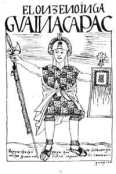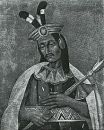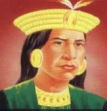Hello! This is part six of a multi-part series on the Inca Empire and the Conquistadors. If you want some background, the introduction to this series is right here, and part five is here. Or, plunge ahead, boldly having no clue what is going on!
Meanwhile, Quizquiz’s army limped north. However, during their retreat, Quizquiz’s weary troops ran into a large army led by Almagro, who had gone north to ward off an excursion by the conquistador Pedro de Alvarado. Both Quizquiz and Almagro were surprised to encounter each other, and battle lines were quickly drawn. With Quizquiz’s forces at the limit of their strength, the hardened general dragged his men into battle by sheer force of personality. Quizquiz fought another series of battles against Almagro, including the greatest Inca victory to date when his men successfully isolated a detachment of fourteen Spanish soldiers and killed them all.
Quizquiz’s soldiers, though, were finished. Faced with countless unstoppable cavalry charges and an implacable, invulnerable foe, Quizquiz’s soldiers had been at war for years and they were tired, hungry, and thoroughly demoralized. Quizquiz’s captains begged him to surrender to the Spanish, a suggestion the general refused out of hand. Quizquiz ordered his captains to form up the men for battle. His captains refused. Quizquiz raged at the mutineers, calling them traitors and cowards, swearing that he would punish each of them severely. Pushed to the brink, Quizquiz’s captains finally snapped. The captains drew their weapons and rushed Quizquiz, who went down in a flurry of clubs and battle-axes. Quizquiz died on the weapons of his own men, and the next day Quizquiz’s army disbanded, the men disappearing into the fields.
At the same time, Pizarro dispatched his lieutenant Sebastian de Belalcazar to the north to eliminate the last army, Ruminavi’s northern veterans.

Artist’s depiction of Ruminavi
Here too Spanish cavalry proved unstoppable. Ruminavi was pushed deeper into the mountains, where he fought a running battle against the Spanish before eventually going to the ground and hiding. After a campaign that was brutal and horrific even by Spanish standards (Belalcazar, upon discovering a village abandoned by its men, ordered the slaughter of every old man, woman and child), Ruminavi was forced out, tortured and killed. The last great general of Atahualpa Inca was dead. Ruminavi, Chalcuchima and Quizquiz had all led disciplined, well-trained Inca regiments against the Spanish, and they had all failed utterly. Chalcuchima had been undone by betrayal, while neither Ruminavi or Quizquiz was ever able to develop a strategy for neutralizing the devastating Spanish cavalry.
Besides crushing the Inca generals, the Spanish had other priorities. The main one, of course, was the division of gold. Both Pizarro’s men and the reinforcements from Almagro proceeded to loot the city and partition the massive amounts of wealth between them. Gold was stripped off the walls of the temples, cups and bowls were melted down, massive ornate statues were Almagro’s men received a huge windfall, while Pizarro’s men had effectively won the lottery twice.
Having won this gigantic empire, Pizarro and Almagro were now faced with the question of how to rule it. The emperor of Spain had given Pizarro the governorship of New Castille, consisting of all the lands conquered to this point, from Tumbez south to Cuzco. Almagro received the governorship of New Toledo, which was the rest of the Incas’ lands from Cuzco on south into Chile.
 Map showing New Castille (In green), owned by Pizarro, and New Toledo (in orange), owned by Almagro.
Map showing New Castille (In green), owned by Pizarro, and New Toledo (in orange), owned by Almagro.
[Apologies for the confusion on this map, New Toledo originally extended much further south. The provinces of New Andalusia and New Leon were not conquered until later]
However, two men alone could not administer an empire. Pizarro eventually decided to make his men an offer. Any man who wished to return to Spain would be allowed to do so, but for those who wished to stay, Pizarro had a deeply tempting offer. Conquistadors who decided to stay would be offered encomiendas, or plantation. Encomenderos would be given de facto rule of a large chunk of land, with all the natural resources and wealth it contained. More importantly, the grant of an encomienda also gave the recipient control over any Indians who lived on the land. The encomendero was theoretically supposed to protect “his” Indians, but in practice they could exploit their subjects as much as they pleased. An encomendero, then, was effectively a feudal landlord, who could rule over a large tract of land, extract frequent tribute from his subjects and live a life of luxury.

An encomendero overseeing his native servants bringing him tribute
Just as clearly as he had on the beach, Pizarro was drawing a line in the sand. On the other side of the Atlantic, the conquistadors could return home, taking back more wealth than they had ever seen before, they could return to their families and their lives in Spain. If they stayed, though, their life would be much more difficult and dangerous, but they could live like lords, with land and power that all the gold in the world would not be able to buy them back in Spain. Eventually, eighty-eight of Pizzaro’s men decided to stay on as encomenderos. The rest returned home, bringing letters and gold from the men who were staying back to their families.
Dates
c. 1200 Kingdom of Cuzco is founded
1438-1471 Reign of Pachachuti
1471-1493 Reign of Tupac Inca
1492 Columbus discovers the Americas
1493-1527 Reign of Huayna Capac
1526 Pizarro and his thirteen men discover the Inca city of Tumbez
1527 Huayna Capac dies of smallpox brought by the Europeans
1527-1531 Civil war between Atahualpa Inca and Huascar
1531 Pizarro’s conquering expedition to Peru, Pizarro captures Atahualpa Inca, Atahualpa executes his brother Huascar
1533 Pizarro executes Atahualpa Inca and installs Manco Inca as the new Inca
Characters
Incas

Huayna Capac – Emperor of the Incas [Died of plague in 1527]

Huascar – Son of Huayna Capac and the heir to the throne [Executed by Atahualpa in 1531]

Atahualpa – Brother of Huascar and rival for the throne, emperor of the Incas [Executed by Pizarro in 1533]
 Manco Inca – Younger brother of Atahualpa and Huascar, emperor of the Incas
Manco Inca – Younger brother of Atahualpa and Huascar, emperor of the Incas
The Pizarros
 Francisco Pizarro – Oldest of the brothers and mastermind of the expedition. A talented leader of men and a good strategist
Francisco Pizarro – Oldest of the brothers and mastermind of the expedition. A talented leader of men and a good strategist
Hernando Pizarro – Second of the brothers; a canny and calculating tactician [Returned to Spain to send the king his share of the treasure in 1533]
 Gonzalo Pizarro – Third brother; charming womanizer with a vicious cruel streak
Gonzalo Pizarro – Third brother; charming womanizer with a vicious cruel streak
Juan Pizarro – Youngest of the brothers and a powerful, impetuous soldier
Almagristas
 Diego Almagro – Partner with Pizarro and one of his oldest friends, a hardened veteran of many battles ready to strike it rich
Diego Almagro – Partner with Pizarro and one of his oldest friends, a hardened veteran of many battles ready to strike it rich
Diego Almagro II – Almagro’s son, a hot-headed young soldier
Royalists
 Cristobal Vaca de Castro – Viceroy of Peru, a flexible and adaptable man
Cristobal Vaca de Castro – Viceroy of Peru, a flexible and adaptable man
 Blasco Nunez Vela – Viceroy of Peru, grating and brusque administrator
Blasco Nunez Vela – Viceroy of Peru, grating and brusque administrator
 Pedro de la Gasca – Viceroy of Peru, a clever politician and adept manipulator
Pedro de la Gasca – Viceroy of Peru, a clever politician and adept manipulator

One thought on “Chapter 6: Conquest and Spoils”